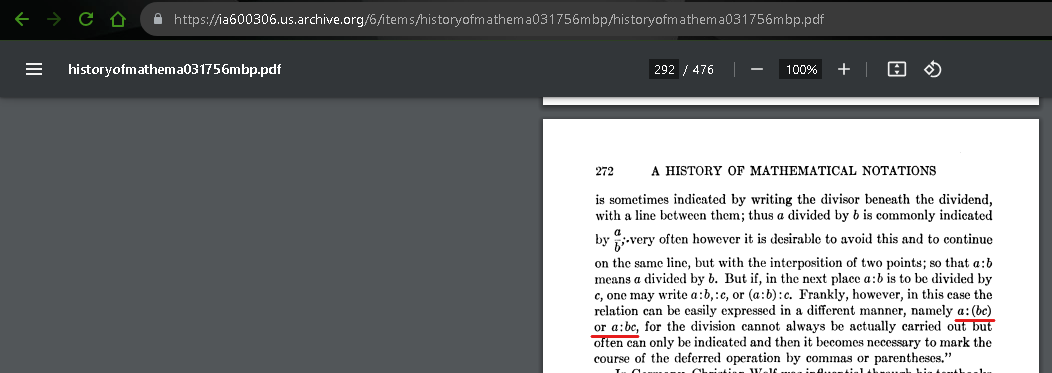The syntax is arbitrary in some edge cases
Such as?
The syntax is arbitrary in some edge cases
Such as?
My calculator says -2² = -4
That’s correct
Unfortunately some calculators, such as Google’s will ignore your brackets and put in their own anyway. You just gotta find a decent calculator in the first place.
Either ‐(n²) or (-n)². Order of operations shouldn’t be some sort of gotcha to trick people into misinterpreting you
It isn’t. With ‐(n²), n² is already a single term, so the brackets aren’t needed.
This is why every calculator should be a RPN calculator
No, this is why programmers should (re)learn the order of operations rules before writing a calculator.
I just used the calc on window… it cannot respect order of operation
Yeah, I’ve tried several times to get Microsoft to fix their calculators. I’ve given up trying now - eventually you have to stop banging your head against the wall.
Math should be just as deterministic as programming, but it’s not in some situations
Maths is 100% deterministic for order of operations. The issue is people not following all of the rules. Order of operations thread index
If they weren’t ambiguous, then you wouldn’t see them getting popular
#MathsIsNeverAmbiguous They get popular because people who don’t remember all the rules of Maths want to argue with the people who do remember all the rules of Maths. #DontForgetDistribution
different systems of infix notation
There’s not different rules of Maths though, and the people “debating” the answer are those who don’t remember all the rules.
Those math questions that rely on purposeful ambiguity in order to drive engagement
#MathsIsNeverAmbiguous The engagement is driven by people not remembering the rules of Maths. #DontForgetDistribution
And WolframAlpha did division before brackets (turned 6/2 into a fraction, thus making it a single term instead of separate terms, all before doing brackets), thus violating the order of operations rules.
They’re arguing about whether Distribution is Multiplication or not. Spoiler alert: it isn’t, it’s Brackets.
when you read a paper that contains math, you won’t see a declaration about what country’s notation is used for things that aren’t defined
Not hard to work out. It’ll be , for decimal point and : for division, or . for decimal point and ÷ or / for division, and those 2 notations never get mixed with each other, so never any ambiguity about which it is. The question here is using ÷ so there’s no ambiguity about what that means - it’s a division operator (and being an operator, it is separating the terms).
Neither is ambiguous. #MathsIsNeverAmbiguous ab=(axb) by definition. Here it is referred to in Cajori nearly 100 years ago (1928), and literally every textbook example quoted by Lennes (1917) follows the same definition, as do all modern textbooks. Did you not notice that the blog didn’t refer to any Maths textbooks? Nor asked any Maths teachers about it.

you can’t prove that some notation is correct and an alternative one isn’t
I never said any of it wasn’t correct. It’s all correct, just depends on what notation is used in your country as to what’s correct in your country.
It’s all just convention.
No, it’s all defined. In Australia we use the obelus, which by definition is division. In European countries they use colon, which by definition in those countries means division. 1+1=2 by definition. If you wanna say 1+1=2 is just a convention then you don’t understand how Maths works at all.
What you are saying is like saying “there’s no such things as dictionaries, there are no definitions, only conventions”.
Maths is pure logic. Notation is communication, which isn’t necessarily super logical. Don’t mix the two up.
Don’t mix up super logical Maths notation with “communication” - it’s all defined (just like words which are used to communicate are defined in a dictionary, except Maths definitions don’t evolve - we can see the same definitions being used more than 100 years ago. See Lennes’ letter).
It was incredibly thorough and well researched
It never mentions the 2 relevant rules of Maths, nor any textbooks, nor speaks to any Maths teachers. You can find all those thing here
Look, this is not the only case where semantics and syntax don’t always map
Syntax varies, semantics doesn’t. e.g. in some places colon is used for division, in others an obelus, but regardless of which notation you use, the interpretation of division is immutable.
they use different semantics for a notation that for you seems to have clear meaning
They might use different notation, but the semantics is universal.
You need to accept that human communication isn’t as perfectly unambiguous as mathematics (writing math down using notation is a way of communicating)
Writing Maths notation is a way of using Maths, and has to be interpreted according to the rules of Maths - that’s what they exist for!
It actually looks trivial as a problem
Because it actually is.
that’s why the article is so long
The article was really long because there were so many stawmen in it. Had you checked a Maths textbook or asked a Maths teacher it could’ve been really short, but you never did either.
It’s not taught 2 different ways. It’s taught the same around the world (the mnemonics are different but the rules are the same), there’s just 2 types of people - those who remember the rules and those who don’t. You’ll notice students never get these questions wrong, only adults who’ve forgotten the rules.
Which is correct